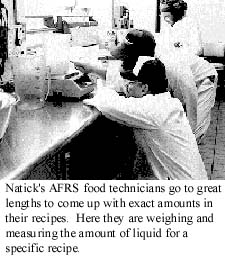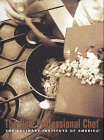
Every Chow Line
Leads to Natick
All Military
Menus Are Tested and Approved at Natick
By Patricia Prell
 When it comes to meals
served to any soldier, sailor, airman or Marine ... all
roads, or at least all chow lines, lead to Natick.
When it comes to meals
served to any soldier, sailor, airman or Marine ... all
roads, or at least all chow lines, lead to Natick.
Natick is the home of the Armed Forces Recipe Service (AFRS), located at the U.S. Army Soldier Systems Center (Natick). One of its missions is to research, develop and field food and food items to the entire Department of Defense.
All of the research to produce the Army’s standardized recipes was done at the Quartermaster Institute in Chicago from 1946 up to 1963. In 1963, facilities and functions were moved to Natick, where the recipe development research continues to this day. In 1963, the Army and Air Force used the same 100-portion recipes, published in a book format, and the Navy and Marine Corps used a separate set of 100-portion recipes, published in a 5 by 8 inch card format. A similar card format is used today by the AFRS, which was established in 1967 when the Office of the Assistant Secretary of Defense determined that a recipe service common to all branches of the military was feasible and cost-effective.
As part of Natick’s food mission, food technicians develop and test all recipes that end up in military dining facilities, whether it is in garrison, in the field, on a submarine or circling the globe in the space shuttle.
The unit is tasked with creating recipes from scratch, modifying existing recipes or implementing recipe ideas that come from outside sources. According to Marion Wollmeringer, food technologist and registered dietitian, “Since 1981, the focus of recipe testing and development for the AFRS has been to increase the availability of healthful food choices in all garrison dining facilities on land and at sea. Recipes have been modified to reduce salt, fat and cholesterol and increase complex carbohydrates and fiber.”
For the last 10 to 15 years, the unit has been working to reduce the fat and cholesterol in soldier’s diets and has exceeded its own expectations. About 70% of the new recipes that will be released next spring to military cooks worldwide will be of the low-fat variety.
Historical Background
In 1775, the Second Continental Congress passed the first legislation to provide its Army with an individual ration that considered the soldier’s nutritional health and diet. The following items were included: One pound of beef, 3/4 pound of pork or one pound of salted fish per week; three pints of peas or beans per week; one half pint of rice or a pint of Indian Meal per week; one pint of milk per day; one pound of flour per day or hard bread once a week; and one quart of spruce beer or cider per day.
Canned foods, an economical and reliable source of nutrition, were first used during the Civil War. Condensed milk, invented by Gail Borden in 1856, and pork and beans produced by Van Camp were occasionally available to Union troops.
Technological advances brought many changes to the military over the ensuing years, but unfortunately improvements in rations were not among them. During the Civil War, rations for the Union troops were ample, but they were neither nutritious nor appetizing. As unfortunate soldiers discovered, a diet of salted meat, no vegetables and hardtack -- a saltless hard biscuit or bread made of flour and water -- can quickly lead to scurvy and night blindness. Fresh meat was available as “beef on the hoof,” which meant that cattle were driven along with the soldiers and slaughtered as needed.
One of the first steps in standardizing ration delivery took place in 1896, when a manual for Army cooks was published by the Commissary General of the U.S. Subsistence Department with recipes for 100 servings. New challenges arose with the start of the Spanish-American War, America’s first military venture overseas. Problems of distant transport and food preservation were overwhelming, and the Army and Navy had no organizational mechanisms for cooperation.
By the end of the war, a clearer understanding of nutrition led to a more balanced system of rations. Better cooking utensils and mess gear were developed and field ranges began to replace camp fires. In 1902, the Army established the first school for military cooks. The same year, the Navy published the “General Mess Manual and Cookbook” with recipes for 100 servings.
During World War I, the United States had to concern itself with feeding five distinct groups: American troops stationed in the U. S.; American troops abroad; the U. S. civilian “home front;” European Allied troops; and European civilians. Herbert Hoover was made “food commissioner” in 1917, as the U.S. entered the war. He was given sweeping power to set prices and to take measures against hoarding and profiteering. In 1918, the Subsistence Department of the Office of the Quartermaster General was established. A Food Purchase Board was created to coordinate purchases of food for the Army, Navy and the Allies. Some food was shipped from the U.S. to Europe, some was purchased in Europe. The Quartermaster Corps even set up its own factories in Europe to make macaroni, bread and candy.
All troops not deployed to the field were issued a Garrison Ration that included canned boneless beef and dehydrated vegetables. As trench warfare began, hot food and drinking water were delivered to the troops in milk cans carried on a pole by two soldiers. This is the first time that hot meals were served on the front lines. The most popular items among the troops were the tobacco and the half pound of candy issued them every 10 days. In all, World War I saw an appreciable upgrading of the standard overseas ration. The “doughboy” diet now included a greater variety of food and a wider use of fresh foods, even in the field.
By the time World War II began, a complex and far-flung food supply, transport and distribution system had been established. The needs of the American forces during that war quickly outpaced the system, however. The scope of the war and the number and diversity of overseas operations presented an enormous challenge, and the logistics of food supply could not be allowed to dictate military strategy. Ration designers were charged with developing lighter weight, nutritionally balanced individual and group rations for 100-man units, survival rations, and unique Air Corps and Navy rations. Due to advances in food technology and assistance from industry and academia, more than 23 different rations and ration supplements were developed. In 1941, the military food services began using standardized recipes with precise quantities of ingredients and preparation methods assuring 100-portion recipes that met nutritional requirements and soldiers’ tastes.
Service men stationed in America were issued the maximum possible fresh meat, fruit and vegetables. Overseas units still depended largely on canned food, dehydrated fruits and “powdered eggs.” Both at home and overseas, the military attempted not only to feed the troops, but to feed them well. Food was generally worse closer to the front lines, though extraordinary efforts were made to get holiday food to combat areas on Thanksgiving and Christmas Day.
After the war, the United States recognized the need for a world-class military food program. In 1946, the Subsistence Department research and development laboratory became the Quartermaster Food and Container Institute for the Armed Forces, located in Chicago. In 1954, the Quartermaster Research and Development Command opened as a new facility in Natick, Mass., and in August 1963, the Quartermaster Food and Container Institute moved from Chicago to Natick and was renamed the U.S. Army Natick Laboratories. The installation later became the Natick Research, Development and Engineering Center (NRDEC), which is now the Soldier Center of Excellence.
Today, Natick is responsible for creating and maintaining a collection of more than 1,500 standardized recipes for the AFRS. These recipes are used by all four branches of the military in dining facilities and hospitals. The requirements and goals of AFRS recipe maintenance, development and testing are standardization, meeting the nutritional initiatives of the Surgeon General, optimizing military consumer acceptance, and efficiently using military food service ingredients, personnel and equipment.
The recipe standardization process encompasses the following factors: yield size, terminology, preparation procedures and equipment, and ingredient weight/volume ratios and as-purchased/edible portion ratios. The nutrition initiatives require recipes with nutrient retention, reduced fat and cholesterol, moderate sodium, and increased complex carbohydrates. Military consumer acceptance requires recipes that optimize the sensory qualities of appearance, flavor, odor and texture; reflect current food-preference trends; and provide options for ethnic and regional favorites, as well as religious, health, vegetarian and reduced-calorie diets. Other concerns include the support of various food service programs, the use of new food items, equipment changes, and the consolidation of recipes to reduce printing costs.
The first edition of the AFRS recipes was published in 1969, and partial revisions are published every two to three years. There are now about 1,500 recipes, variations and guideline cards in the AFRS file, as well as 69 photos illustrating finished products and illustrations for difficult procedures. A Recipe Development Database System has also been developed for use at Natick, expediting all recipe development functions and providing the four services with up-to-date recipes on a regular basis. Thanks to the work done by Natick, troops now enjoy a wide variety of wholesome, tasty foods that reflect the ethnic, religious, and geographical diversity that today’s Army embraces.
From the November-December 1998 issue of The Warrior.
| Bulletin Board | Keyword Search |
| Bookstore | Links |
| About Us | Recent Additions |

